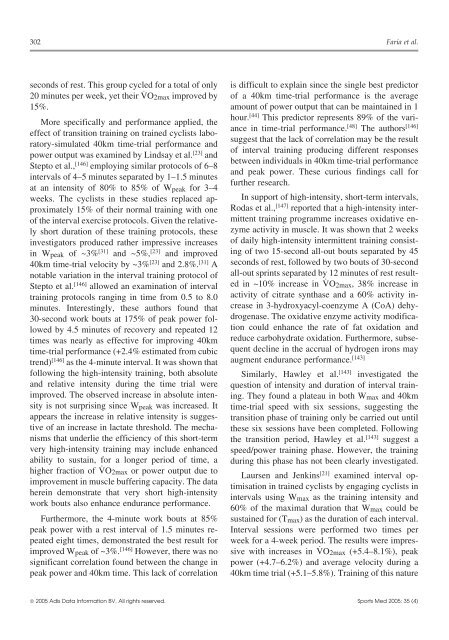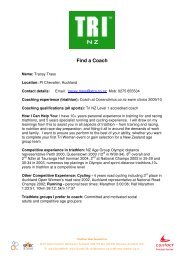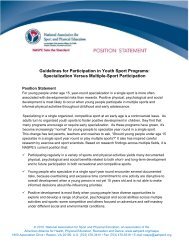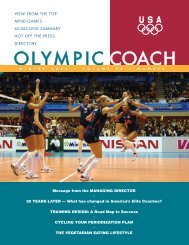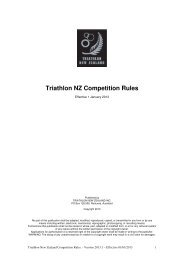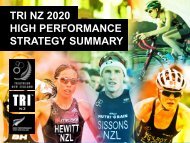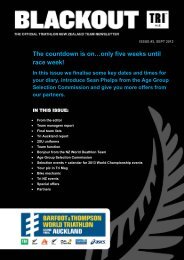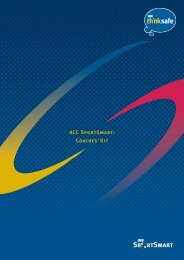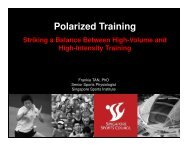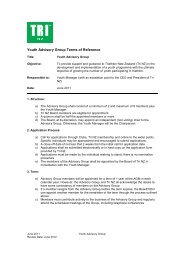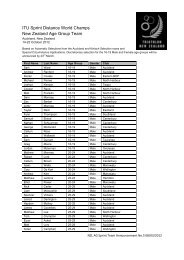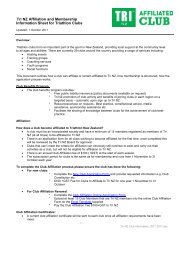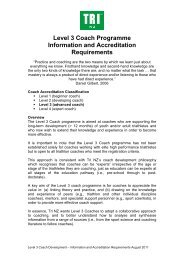The Science of Cycling - IngentaConnect
The Science of Cycling - IngentaConnect
The Science of Cycling - IngentaConnect
You also want an ePaper? Increase the reach of your titles
YUMPU automatically turns print PDFs into web optimized ePapers that Google loves.
302 Faria et al.<br />
seconds <strong>of</strong> rest. This group cycled for a total <strong>of</strong> only<br />
20 minutes per week, yet their ˙VO2max improved by<br />
15%.<br />
More specifically and performance applied, the<br />
effect <strong>of</strong> transition training on trained cyclists labo-<br />
ratory-simulated 40km time-trial performance and<br />
power output was examined by Lindsay et al. [23] and<br />
Stepto et al., [146] employing similar protocols <strong>of</strong> 6–8<br />
intervals <strong>of</strong> 4–5 minutes separated by 1–1.5 minutes<br />
at an intensity <strong>of</strong> 80% to 85% <strong>of</strong> Wpeak for 3–4<br />
weeks. <strong>The</strong> cyclists in these studies replaced approximately<br />
15% <strong>of</strong> their normal training with one<br />
<strong>of</strong> the interval exercise protocols. Given the relative-<br />
ly short duration <strong>of</strong> these training protocols, these<br />
investigators produced rather impressive increases<br />
in Wpeak <strong>of</strong> ~3% [31] and ~5%, [23] and improved<br />
40km time-trial velocity by ~3% [23] and 2.8%. [31] A<br />
notable variation in the interval training protocol <strong>of</strong><br />
Stepto et al. [146] allowed an examination <strong>of</strong> interval<br />
training protocols ranging in time from 0.5 to 8.0<br />
minutes. Interestingly, these authors found that<br />
30-second work bouts at 175% <strong>of</strong> peak power fol-<br />
lowed by 4.5 minutes <strong>of</strong> recovery and repeated 12<br />
times was nearly as effective for improving 40km<br />
time-trial performance (+2.4% estimated from cubic<br />
trend) [146] as the 4-minute interval. It was shown that<br />
following the high-intensity training, both absolute<br />
and relative intensity during the time trial were<br />
improved. <strong>The</strong> observed increase in absolute intensity<br />
is not surprising since Wpeak was increased. It<br />
appears the increase in relative intensity is suggestive<br />
<strong>of</strong> an increase in lactate threshold. <strong>The</strong> mechanisms<br />
that underlie the efficiency <strong>of</strong> this short-term<br />
very high-intensity training may include enhanced<br />
ability to sustain, for a longer period <strong>of</strong> time, a<br />
higher fraction <strong>of</strong> ˙VO2max or power output due to<br />
improvement in muscle buffering capacity. <strong>The</strong> data<br />
herein demonstrate that very short high-intensity<br />
work bouts also enhance endurance performance.<br />
Furthermore, the 4-minute work bouts at 85%<br />
peak power with a rest interval <strong>of</strong> 1.5 minutes repeated<br />
eight times, demonstrated the best result for<br />
improved Wpeak <strong>of</strong> ~3%. [146] However, there was no<br />
significant correlation found between the change in<br />
peak power and 40km time. This lack <strong>of</strong> correlation<br />
is difficult to explain since the single best predictor<br />
<strong>of</strong> a 40km time-trial performance is the average<br />
amount <strong>of</strong> power output that can be maintained in 1<br />
hour. [44] This predictor represents 89% <strong>of</strong> the variance<br />
in time-trial performance. [48] <strong>The</strong> authors [146]<br />
suggest that the lack <strong>of</strong> correlation may be the result<br />
<strong>of</strong> interval training producing different responses<br />
between individuals in 40km time-trial performance<br />
and peak power. <strong>The</strong>se curious findings call for<br />
further research.<br />
In support <strong>of</strong> high-intensity, short-term intervals,<br />
Rodas et al., [147] reported that a high-intensity inter-<br />
mittent training programme increases oxidative enzyme<br />
activity in muscle. It was shown that 2 weeks<br />
<strong>of</strong> daily high-intensity intermittent training consist-<br />
ing <strong>of</strong> two 15-second all-out bouts separated by 45<br />
seconds <strong>of</strong> rest, followed by two bouts <strong>of</strong> 30-second<br />
all-out sprints separated by 12 minutes <strong>of</strong> rest result-<br />
ed in ~10% increase in ˙VO2max, 38% increase in<br />
activity <strong>of</strong> citrate synthase and a 60% activity in-<br />
crease in 3-hydroxyacyl-coenzyme A (CoA) dehy-<br />
drogenase. <strong>The</strong> oxidative enzyme activity modification<br />
could enhance the rate <strong>of</strong> fat oxidation and<br />
reduce carbohydrate oxidation. Furthermore, subse-<br />
quent decline in the accrual <strong>of</strong> hydrogen irons may<br />
augment endurance performance. [143]<br />
Similarly, Hawley et al. [143] investigated the<br />
question <strong>of</strong> intensity and duration <strong>of</strong> interval train-<br />
ing. <strong>The</strong>y found a plateau in both Wmax and 40km<br />
time-trial speed with six sessions, suggesting the<br />
transition phase <strong>of</strong> training only be carried out until<br />
these six sessions have been completed. Following<br />
the transition period, Hawley et al. [143] suggest a<br />
speed/power training phase. However, the training<br />
during this phase has not been clearly investigated.<br />
Laursen and Jenkins [21] examined interval op-<br />
timisation in trained cyclists by engaging cyclists in<br />
intervals using Wmax as the training intensity and<br />
60% <strong>of</strong> the maximal duration that Wmax could be<br />
sustained for (Tmax) as the duration <strong>of</strong> each interval.<br />
Interval sessions were performed two times per<br />
week for a 4-week period. <strong>The</strong> results were impres-<br />
sive with increases in ˙VO2max (+5.4–8.1%), peak<br />
power (+4.7–6.2%) and average velocity during a<br />
40km time trial (+5.1–5.8%). Training <strong>of</strong> this nature<br />
© 2005 Adis Data Information BV. All rights reserved. Sports Med 2005; 35 (4)


